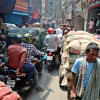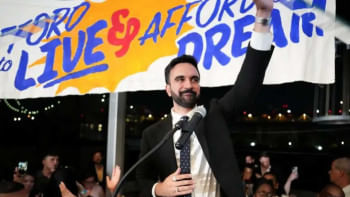Goodbye master planning - Hello bottom-up urbanism
Cities are by nature messy. Unless they are Brasilia, Chandigarh or Myanmar's gaudy new capital Naypyidaw, cities grow organically, with order and chaos,hope and despair. They take shape incrementally, sometimes with good results, sometimes not so good. Urbanisation, like modernisation and democratic institutions, is a chaotic process.
One of the greatest flaws of modern urban planners was their failure to understand the city as a complex organism. Rather, they often saw it as a big drawing on the office table, a drawing that they could change, enlarge, or rearrange at will. The principles of modern planning were established during the 1920s and 1930s in the West. Metropolises like London, Paris, Vienna, and New York grew unsustainably around the turn of the 20th century, as a result of rural-to-urban migration, industrialisation, immigration, population boom, and development. And, during this time, sanitation, street congestion, poverty, and urban crime became topics of intense national debate.
The need to fix cities - particularly how to make them functional for a burgeoning city population - was urgently felt. This situation led to the creation of a robust bureaucratic process of zoning urban functions, providing social housing, creating vehicular roads, centralising urban administration, and, above all, master planning. The future of the city became the task of a few city administrators and appointed master planners. The concept of master planning became the epitome of a top-down model of facilitating and controlling of the city's growth. Master planners often delivered visions for the future, as many critiques claimed, from their office rooms, and urbanites became the passive recipients of their grand master plans.
The orthodoxy of master planning has been questioned since the 1960s and 1970s, particularly with the proliferation of people-centric views of cities and environmental movements. In her classic The Death and Life of Great American Cities (1961), the amateur urban observer Jane Jacobs unleashed a blistering attack on the dogmas of modern urban planning. She argued that the idea of a master planner, imposing a grand urban order on an existing city from above without adequate public debate and participation, is simply misguided.This authoritarian attitude, she claimed, diminishes the city's ability to be livable, vibrant, and socially sustainable. There were other critics. In Collage City (1978), Colin Rowe and Fred Koetter, two Cornell University professors, proposed a more grounded, self-critical alternative to the fit-all modern urban planning principles.
The attitude toward how to administer urban growth has shifted even more dramatically in recent times, particularly against the backdrop of energy crisis, global warming, and rising global urban population (more than 50 percent of the world's population now live in cities). City planning has become a multidisciplinary exercise in public participation, ecological stewardship, accessibility, livability, low-emission lifestyles, pedestrianism, and green development.
Urbanisation and democratisation of society are now seen as deeply intertwined. Liveable cities are increasingly considered products of a creative blend of empathetic urban governance and bottom-up, public-interest initiatives. The myth of an all-knowing master, looking at the world from the sanitised distance of his lofty office and proposing a grand master plan for the city, has largely been debunked. Tactical, problem-specific, and small-scale urban interventions are more and more adopted as effective ways to transform cities from below and the grassroots.
Recently, I was wandering around in Dhaka and Chittagong to understand the state of urbanisation in Bangladesh. It seemed to me that new ideas on urban development have not yet permeated the planning mindset in Bangladesh. The old master-planning attitude persists. The signs of development are everywhere though. Streets are throbbing with the excitement of economic growth. Nobody is sitting idle. A culture of entrepreneurship is visible everywhere. Flyovers, both operational and under construction, seem to be symbolising a rising nation.
Yet, cities like Dhaka and Chittagong feel infernal, caught in at least two types of dysfunctionalities.
First, city administrations seem to prioritise "development" (such as large housing districts, flyovers, or so-called street beautification) over-liveability, and urbanites grind along through an urban maze of various impossibilities (such as traffic congestion). Consider this. A number of new five-star hotels are being built near Dhaka's international airport. This is surely a sign of the capital's rising stature. But it takes more than an hour to go from Uttara to the airport, a distance of only a few kilometres. How does one define development, I kept wondering? In Chittagong, I saw a massive billboard, advertising diamond jewellery, right over a huge overflowing dumpster. No one on the street seems to notice such a blatant contradiction. Does the absurd coexistence of gems and the filth suggest a dangerously low national threshold of hygiene?
Second, and my key contention in this article, cities still seem to be in the grip of an old style master planning culture. A central office (Rajuk or City Corporation) is fixated on delivering an expansion-oriented and automobile-centric mega-vision for the city that leaves room neither for experimental, problem-solving micro-interventions, nor citizen participation. Some city officials in some office rooms have already sorted it all out (often serving the interest of a minority) and would impose a master plan on the city as a sure fire template for future growth.
Purbachal is an example of the grand old master planning mentality. It expands Dhaka's eastern frontier, while also snuffing out the life of Balu River, an important natural water channel for the city. From his ivory tower, the master planner only sees the city in utopian simplicity. The urgency of preserving a river is hardly a priority from that perspective. It will not help to blame land grabbing alone. There is major problem in the way city administrators envision the future of the city (city as a mega-shop or a mega-collection of plots for the moneyed class).
It's time to say goodbye to master planning and welcome bottom-up urbanism. It is time to do street level urban interventions that would transform the city from below. In line with many successful urban policies pursued in developed and developing countries in recent times, street level urbanism suggests looking at the problem not from the impossible heights of the old styled master planner, but from within the problem itself, with the participation of all stakeholders, so that enduring positive transformations of cities could be achieved.
Given the range and nature of urban problems that cities in Bangladesh face - from bus syndicates on city streets to land grabbing mafia, from disappearing wetlands to unnecessary bureaucratisation of urban governance—the idea of fixing or bettering cities with the sweeping brushstrokes of the master planner will simply not work.
What cities in Bangladesh need are plenty of examples of small scale urban solutions that can bypass the lengthy bureaucratic approval process, are quickly implementable, and most of all, can be experienced by city people to see for themselves what an effective urban solution is. People need to see what good is, more and more. Only then could the city be sustainably transformed, with all stakeholders contributing to the process. The master planner, whoever he or she is, can't do it alone from above. Megaprojects can be dropped from the sky, but their effects would be tragically short-lived. This is not a debate between comprehensive vs. piecemeal or long-term vs. short-term. A long term vision for the city is useful, but what should happen are tactical urban interventions that would transform the city by multiplication.
The mayor of North Dhaka has recently undertaken various urban cleansing initiatives, but, alas, with a master-planner attitude. It is going to be virtually impossible to recapture Dhaka's footpaths from vendors with one grand executive order. What may work instead is focusing on ONE urban node, such as Farmgate. Clean up the footpaths of this major urban junction and show that it works for vehicles, pedestrians, and local businesses alike, while vendors relocate to a designated area elsewhere.
The mayor indicated that 3000 public buses would be introduced to Dhaka streets in the next two years. This is again a master planning mindset of the yore. The bottom-up question to ask is this: could the mayor's office try out just one bus route with complete efficiency (modern ticketing system, time and itinerary management, designated passenger stations, etc.) and see if the rising middle-class would shun private cars and use public transportation? After all, 70 percent of the road space is occupied by private cars. Do more small projects and demonstrate what good solutions are. People need to see what works and be inspired to follow suit.
There is a lot of social activism on urban issues in Bangladesh but very few inspiring solutions to actual problems. Activism is important, but, at the end of the day, people need to see tangible solutions. Urban problems in Bangladesh, often linked to complicated political domains and social norms, do not seem amenable to wholesale reform. Incremental transformation of cities may work.
The writer is an architect, urbanist, architectural historian, and columnist. He teaches at the Catholic University of America in Washington, DC, and is the author of Impossible Heights: Skyscrapers, Flight, and the Master Builder (University of Minnesota Press, 2015) and Oculus: A Decade of Insights into Bangladeshi Affairs (UPL, 2012).

 For all latest news, follow The Daily Star's Google News channel.
For all latest news, follow The Daily Star's Google News channel. 








Comments